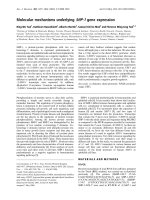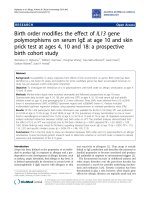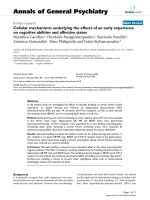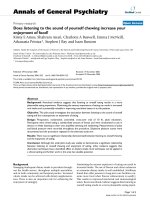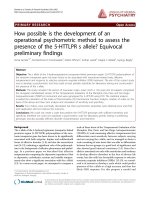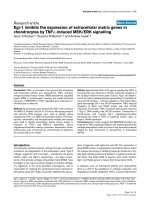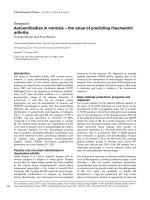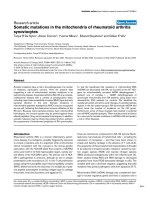Báo cáo y học: "Cellular mechanisms underlying the effects of an early experience on cognitive abilities and affective states." ppt
Bạn đang xem bản rút gọn của tài liệu. Xem và tải ngay bản đầy đủ của tài liệu tại đây (570.21 KB, 11 trang )
Annals of General Psychiatry
BioMed Central
Open Access
Primary research
Cellular mechanisms underlying the effects of an early experience
on cognitive abilities and affective states
Efstathios Garoflos†, Theofanis Panagiotaropoulos†, Stavroula Pondiki†,
Antonios Stamatakis†, Eleni Philippidis and Fotini Stylianopoulou*
Address: Lab. Biology-Biochemistry, Dept. Basic Sciences, Faculty of Nursing, University of Athens, Papadiamantopoulou 123, 115 27 Athens,
Greece
Email: Efstathios Garoflos - ; Theofanis Panagiotaropoulos - ;
Stavroula Pondiki - ; Antonios Stamatakis - ; Eleni Philippidis - ;
Fotini Stylianopoulou* -
* Corresponding author †Equal contributors
Published: 06 April 2005
Annals of General Psychiatry 2005, 4:8
doi:10.1186/1744-859X-4-8
Received: 03 February 2004
Accepted: 06 April 2005
This article is available from: />© 2005 Garoflos et al; licensee BioMed Central Ltd.
This is an Open Access article distributed under the terms of the Creative Commons Attribution License ( />which permits unrestricted use, distribution, and reproduction in any medium, provided the original work is properly cited.
Abstract
In the present study we investigated the effects of neonatal handling, an animal model of early
experience, on spatial learning and memory, on hippocampal glucocorticoid (GR),
mineralocorticoid (MR) and type 1A serotonin (5-HT1A) receptors, as well as brain derived
neurotrophic factor (BDNF), and on circulating leptin levels, of male rats.
Method: Spatial learning and memory following an acute restraint stress (30 min) were assessed
in the Morris water maze. Hippocampal GR, MR and BDNF levels were determined
immunocytochemically. 5-HT1A receptors were quantified by in vitro binding autoradiography.
Circulating leptin levels, following a chronic forced swimming stress, were measured by
radioimmunoassay (RIA). Data were statistically analyzed by analysis of variance (ANOVA).
Results: Neonatal handling increased the ability of male rats for spatial learning and memory. It
also resulted in increased GR/MR ratio, BDNF and 5-HT1A receptor levels in the hippocampus.
Furthermore, leptin levels, body weight and food consumption during chronic forced swimming
stress were reduced as a result of handling.
Conclusion: Neonatal handling is shown to have a beneficial effect in the males, improving their
cognitive abilities. This effect on behavior could be mediated by the handling-induced increase in
hippocampal GR/MR ratio and BDNF levels. The handling-induced changes in BDNF and 5-HT1A
receptors could underlie the previously documented effect of handling in preventing "depression".
Furthermore, handling is shown to prevent other maladaptive states such as stress-induced
hyperphagia, obesity and resistance to leptin.
Background
It is generally accepted that early experiences have profound influences on brain development and thus on adult
brain function and behavior. However the neurobiologi-
cal mechanisms involved still remain elusive. An animal
model employed in experiments aiming to elucidate such
mechanisms is "neonatal handling" [1]. This manipulation alters hypothalamic-pituitary-adrenal (HPA) axis
Page 1 of 11
(page number not for citation purposes)
Annals of General Psychiatry 2005, 4:8
function and the ability of the organism to respond to
stressful stimuli [1]. Thus, as adults, neonatally handled
rats are less emotionally reactive, synthesize and secrete
less corticotropin-releasing factor, adrenocorticotropin
hormone (ACTH) and corticosterone following a variety
of stressors [2], and their stress-induced secretion is more
short-lived [3]. These differences in HPA axis reactivity
have been attributed to an enhanced sensitivity of the negative-feedback loop [2], due to a handling-induced
increase in the number of type II glucocorticoid receptors
(GR) in the hippocampus [2].
In addition to GR, glucocorticoids also bind to type I
(MR) receptors, and the hippocampus is rich in both these
types of receptors [4]. GR and MR receptors are the molecules mediating the negative feedback control exerted by
glucocorticoids on HPA axis function [5]. Furthermore
GRs and MRs influence spatial learning, a process controlled by the hippocampus [6]. MRs have a role in behavioral
reactivity during novel situations [7], whereas GRs are
involved in consolidation of learned information. In
addition to GRs and MRs, glucocorticoid levels also play a
determinant role in the ability for learning and memory.
The effect of corticosteroid levels on cognition exhibits a
U-shaped dose-response dependency [8]. Interestingly, as
mentioned above, handled animals have lower corticosterone levels following stress [9], which could alter their
ability for learning and memory.
Another molecule that has been shown to play a key-role
in the cellular processes underlying learning and memory
is Brain Derived Neurotrophic Factor (BDNF), a member
of the neurotrophin family [10]. BDNF mRNA is
increased during LTP, indicating that BDNF is involved in
plastic changes of neuronal function [11]. Memory acquisition is also associated with increased BDNF mRNA and
activation of its receptor TrkB [12,13]. On the other hand,
LTP is markedly impaired in BDNF mutant mice and the
deficit is restored by the re-expression of BDNF [14,15].
Moreover, BDNF mutant mice show learning deficits [16].
Similarly, the pharmacologic deprivation of BDNF or its
receptor TrkB, results in severe impairment of learning
and memory in mice, rats and chicks [15]. BDNF mutant
mice develop enhanced aggressiveness, and hyperphagia,
accompanied with weight gain in early adulthood, findings reminiscent of dysfunction of the serotoninergic system [17]. Indeed BDNF is known to have trophic effects
on serotoninergic neurons [18]. It is well known that
depression is associated with hypofunctioning of the serotoninergic system. Recently BDNF has emerged as a major
factor in the pathophysiology of depression: BDNF mRNA
is increased in the rat brain following chronic anti-depressant or electro-convulsive shock treatment [19,20].
Administration of BDNF in the hippocampus has been
shown to have an anti-depressant effect in the forced
/>
swimming and learned helplessness paradigm [21]. Furthermore, in patients with major depression, serum BDNF
levels were decreased, while hippocampal BDNF immunoreactivity was increased in post-mortem tissues from
subjects treated with anti-depressants [22]. Previous
results from our laboratory have shown that handled
males exhibit decreased expression of "depressive" behavior [26].
Recent evidence indicates that among the serotonin receptors, the type 1A are involved in the etiopathogenesis of
certain types of depression [23,24] and is the one through
which the therapeutic effects of the Selective Serotonin Reuptake Inhibitors (SSRIs), a major class of antidepressants, are mediated [25]. Results from our laboratory have
shown that handled male rats show increased 5-HT1A
receptor sensitivity as assessed by the hypothermic
response to 8-OH-DPAT compared to the non-handled
[26].
Depression and the response to chronic stress are often
associated with disorders in food-intake behavior, which
is influenced by serotonin and, as mentioned above, by
BDNF. A key hormone regulating food-intake behavior is
leptin, the product of the ob gene [27]. Leptin, whose levels reflect the organism's current energy balance, is
secreted from adipose tissue proportionally to body fat
mass and acts on the CNS to limit food intake, and thus
promote body weight loss [28]. Recent evidence indicates
that glucocorticoids induce leptin synthesis and secretion
and that, conversely, leptin participates in the regulation
of HPA axis function [29].
Thus, we investigated the effects of "neonatal handling"
on factors influencing cognitive abilities and affective
states of the adult rat. Specifically, we determined the
"neonatal handling" effects on A. the ability for spatial
learning and memory -in the Morris water maze- when a
short-term restrain stress has preceded the learning process, B. GR and MR levels in the hippocampus after the
completion of the Morris water maze test, C. BDNF levels
in the hippocampus, D. hippocampal 5-HT1A receptor
density and E. plasma leptin levels, food intake and body
weight change during long term forced swimming stress.
Methods
Animals
Male Wistar rats reared in our laboratory were kept under
standard conditions (24°C; 12:12 h light/dark cycle; food
and water ad libitum). All animal experimentations were
carried out in agreement with ethical recommendation of
the European Communities Council Directive of 24
November 1986 (86/609/EEC). In total, 43 handled and
45 non-handled (control) animals were used in this
study.
Page 2 of 11
(page number not for citation purposes)
Annals of General Psychiatry 2005, 4:8
Neonatal handling
Pups were removed from their mothers and placed for 15
min in a plastic container lined with paper towel, daily
from postnatal day 1 until weaning (postnatal day 22).
The non-handled animals were left completely undisturbed until weaning.
Restraint stress
Adult, handled and non-handled males were placed in a
cylinder 15 cm in length and 5 cm in diameter for 30 min.
Spatial learning and memory test
The Morris water maze (MWM) apparatus was a circular
galvanized tank (1.38 m in diameter, 0.5 m in height),
filled to a depth of 28 cm with water (24°C), made
opaque with milk. The training session took place 90 min
after the completion of the restraint stress. For this session
a 2 cm submerged platform (13 × 13 cm) was placed in a
fixed position. The single training session consisted of 8
trials with 4 different starting positions. After finding the
platform, the animals were allowed to remain on it for 20
sec and were then placed in a holding cage for 30 sec until
the beginning of the next trial. The testing trial was performed 24 hours later. It consisted of a 60 sec free swim
period without a platform and was recorded on videotape. The rat was placed in the tank at a position directly
opposite to the imaginary platform quadrant. Animals
were sacrificed upon termination of the testing session
and their brains were used for GR and MR
immunocytochemistry.
Immunocytochemistry
For the GR and MR immunocytochemistry the same animals were used, whereas for the BDNF immunocytochemistry a different set of animals was employed. All animals
were deeply anesthetized with ether and perfused transcardially with 4% paraformaldehyde in 0.1 M phosphate
buffer (PB). Immunocytochemistry was performed as previously reported [30] on paraffin, sagittal brain sections (6
µm). The primary antibodies used were an anti-BDNF rabbit polyclonal antibody (Santa Cruz) or an anti-MR goat
polyclonal antibody (Santa-Cruz) or an anti-GR moloclonal antibody (kindly provided by Dr. Alexis, NHRF).
The secondary antibodies were biotinylated goat anti-rabbit or rabbit anti-goat or rabbit anti-mouse antibody
respectively (DAKO). Staining of the immunopositive
cells was performed using the DAKO ABC reagent followed by the 3,3'-diaminobenzidine (DAB) reaction. The
number of immunopositive cells was evaluated using
Image-Pro Plus program (Media Cybernetics, USA), in 3–
5 sections from each brain, and an average value was calculated for each of the areas studied per animal.
/>
In vitro binding
Animals used for 5-HT1A receptor autoradiogarphy were
killed by decapitation under ether anesthesia. Their brains
were frozen at -40°C in dry-ice cooled isopentane and
subsequently cut coronally (10 µm) in a cryostat (-17°C).
The sections were processed using standard autoradiographic procedures [31,32]. Briefly, the localization of 5HT1A receptors was performed using 4 nM 3H-8-OHDPAT (129Ci/mmol, NEN) and non-specific binding was
determined in the presence of 10 µM serotonin. Bound
3H-8-OH-DPAT was visualized by exposing the labeled
sections to tritium-sensitive film (Biomax, KODAK) (4oC,
1 month) along with 3H-standards (3H-microscales,
ARC). Quantitative image analysis of the autoradiograms
was performed using SCION-Image for Windows. Specific
binding, >95% of the total binding, was expressed as
fmol/mgr tissue.
Long term forced swimming
On each of 15 consecutive days adult handled and nonhandled male animals were placed for 5 min in a glass cylinder 33 cm in height and 20 cm in diameter containing
tap water at 24°C.
Body weight measurement
During the period of the long term forced swimming handled and non-handled animals were weighed daily prior
to the exposure to the stressful stimulus. Moreover, the
amount of food consumed daily was determined for each
one of these animals.
Determination of plasma leptin levels
Immediately after the last exposure to long term forced
swimming (day 15) blood samples from all animals were
collected by cardiac puncture under ether anesthesia,
using heparinized syringes, and centrifuged to obtain
plasma. Leptin concentrations were determined by RIA
(Linco's™ rat leptin [125I] assay system).
Statistical Analysis
Data were analyzed by a one-way analysis of variance
(ANOVA) with handling as the independent factor. Data
on learning, body weight and food intake were analyzed
by a one-way ANOVA with repeated measures (handling
served as the independent factor and days of training
served as the repeated factor). All tests were performed
with the software SPSS for Windows (10.0.1, SPSS Inc.).
Differences were considered as significant if p < 0.05.
Results
Following exposure to a short term restraint stress handled animals displayed a greater ability for spatial learning in the Morris water maze, as shown by the lower mean
escape latencies (time to find the submerged platform) of
the handled animals during the acquisition of the task
Page 3 of 11
(page number not for citation purposes)
Annals of General Psychiatry 2005, 4:8
/>
A
120
NO N HANDLED
HANDLED
100
SECONDS
80
60
40
20
0
1
2
3
B
4
5
6
7
8
NO N HANDLED
HANDLED
25
SE
CONDS
20
15
10
5
0
TARGET
O PPO S ING
Effects of handling on spatial learning and memory in the Morris water maze following an acute restraint stress
Figure 1
Effects of handling on spatial learning and memory in the Morris water maze following an acute restraint
stress. A. Mean escape latencies-Learning: handled animals took less time to find the submerged platform during the 8 learning
trials compared to the non handled (p = 0.05, one way ANOVA with repeated measures). Values represent mean escape latencies ± S.E.M.B. Memory: handled animals spent more time in the target and less in the opposing quadrant compared to the non
handled (p = 0.024, one way ANOVA with repeated measures). Values represent the mean time spent in each quadrant ±
S.E.M.
Page 4 of 11
(page number not for citation purposes)
Annals of General Psychiatry 2005, 4:8
/>
MR
GR
NON-HANDLED
NON-HANDLED
HANDLED
HANDLED
45
NO N HANDLED
HANDLED
40
35
30
25
20
15
10
5
0
NUM R OF POSIT
VE
IVE CE L
L S
NUM R OF POSIT
VE
IVE CE L
L S
45
NO N HANDLED
HANDLED
40
35
30
25
20
15
10
5
0
C A2
C A2
Figure 2
Effects of handling on MR and GR immunoreactivity in the CA2 region of the hippocampus
Effects of handling on MR and GR immunoreactivity in the CA2 region of the hippocampus. Handling decreased
the number of MR positive cells (p = 0.042, one way ANOVA) but increased the number of GR positive cells (p = 0.002, one
way ANOVA) in the CA2 region of the hippocampus. The arrow points to a GR positive cell. Values represent means ± S.E.M.
Page 5 of 11
(page number not for citation purposes)
Annals of General Psychiatry 2005, 4:8
/>
A. NON HANDLED
NON HANDLED
HANDLED
B. HANDLED
NUMBER OF POSITIVE CELLS
35
30
25
20
15
10
5
0
CA4
Figure handling on BDNF immunoreactivity in the CA4 region of the hippocampus
Effect of3
Effect of handling on BDNF immunoreactivity in the CA4 region of the hippocampus. Handling resulted in
increased number of BDNF positive cells in the CA4 (p < 0.001, one way ANOVA) region of the hippocampus. The arrow
points to a neuronal process. Values represent the mean number of BDNF positive cells ± S.E.M
(F1,15 = 4.565, p = 0.05) (Fig. 1A). Furthermore, handled
animals spent more time in the target, and less in the
opposing quadrant during the probe trial (F1,15 = 6.320, p
= 0.024) (Fig. 1B), indicating superior mnemonic function (better consolidation of information). The effects of
"neonatal handling" on cognition were accompanied by
changes in GR and MR hippocampal levels: Higher GR
and lower MR levels were found in the CA2 region of the
hippocampus of handled, compared to the non-handled
animals, following their exposure to the Morris water
maze (F1,13 = 14.632, p = 0.002 and F1,13 = 5.268, p =
0.042, respectively) (Fig. 2).
"Neonatal handling" resulted in increased number of
BDNF immunopositive cells, in the CA4 region of the hippocampus (F1,13 = 35.388, p < 0.001) (Fig. 3). BDNF
immunoreactivity was clearly localized in the cytoplasm.
The BDNF positive cells were large, with typical neuronal
morphology, including processes (see arrow).
"Neonatal handling" increased the density of 5-HT1A
receptors in the hippocampus (areas CA1, CA2, CA4 and
DG) as revealed by 3H-8-OH-DPAT binding (F1,13 = 9.170,
p = 0.027). Notably, the CA3 region was devoid of any
detectable labeling (Fig. 4).
Page 6 of 11
(page number not for citation purposes)
Annals of General Psychiatry 2005, 4:8
CA3
HANDLED
250
fmoles/mgr tissue
NON-HANDLED
/>
CA1
DG
200
150
NON-HANDLED
100
HANDLED
50
0
5-HT1A
Figure 4
Effects of handling on the density of 5-HT1A receptors in the hippocampus
Effects of handling on the density of 5-HT1A receptors in the hippocampus. Neonatal handling increased the
number of 3H-8-OH-DPAT binding sites in the hippocampus (p = 0.027, one way ANOVA), indicating an increased density of
5-HT1A receptors in this area. Values represent the mean ± S.E.M. of 5-HT1A receptor density in fmoles/mgr tissue.
NON HANDLED
4
HANDLED
ng/ml
3
2
1
0
LEPTIN
Figure handling on leptin secretion following long term forced swimming stress
Effect of5
Effect of handling on leptin secretion following long term forced swimming stress. Handled animals had lower
plasma leptin levels after long term forced swimming, (p = 0.047, one way ANOVA). Values represent mean leptinlevels ±
S.E.M
Page 7 of 11
(page number not for citation purposes)
gr food consumed/100gr body weight
Annals of General Psychiatry 2005, 4:8
/>
NON HANDLED
14
HANDLED
9
4
1
2
3
4
5
6
7
8
9
10 11 12 13 14
day
Figure handling on food consumption during long term forced swimming stress
Effect of6
Effect of handling on food consumption during long term forced swimming stress. Handled animals consumed less
food during long term forcedswimming (p = 0.05, one way ANOVA). Values represent the mean of food consumed in gr/100
gr body weight ± S.E.M
Handled animals had lower plasma leptin levels (F1,45 =
4.163 p = 0.047), (Fig. 5), consumed less food (F1,15=
4.580, p = 0.05), (Fig. 6), and gained less weight (F1,15 =
7.392, p = 0.017) during long-term forced swimming
stress, compared to the non-handled (Fig. 7).
Discussion
Neonatal handling has beneficial effects in the male rats.
In addition to its well-documented effects in increasing
their ability to cope with stress [2,3], our present results
show that it also improves their cognitive abilities. Furthermore, handling resulted in increased hippocampal
GR and decreased MR levels. The observed increase in the
GR/MR ratio reflects prevalence of GR-mediated effects
and implies an increased HPA axis sensitivity. It is noteworthy that the handling-induced increase in basal GR
levels, shown by others, [33] persists after exposure to a
short-term restraint stress, followed by the Morris water
maze as shown by the present results. The superior mnemonic performance of the handled animals could be
attributed to the increased levels of GR, since they are
involved in the consolidation of learned information and
their activation is a prerequisite for optimal memory [5].
Furthermore, our results show that handling increases
BDNF. BDNF levels are known to be positively related to
learning as well as to have anti-depressive effects. This is
particularly interesting in relation both to the present data
regarding the effects of handling on learning and memory
and our previous results showing that handled males
show less "depressive" behavior as assessed by shorter
immobility times in the chronic forced swimming stress
[26]. It thus appears that handling protects males from
chronic stress-induced "depressive" behavior, possibly by
increasing basal BDNF levels.
Another pathway underlying the protective effects of handling against stress could involve the serotoninergic system, since our results show that handling increases 5HT1A receptors, which are directly involved in the action
of anti-depressants. Furthermore, results from our laboratory have shown that handling also increases serotonin
levels [34]. Interestingly, BDNF has been shown to have a
trophic effect on serotoninergic neurons [18] and in general to interact with the serotoninergic system [17].
Among its actions presumed to be mediated through such
mechanisms are the effects on appetite, body weight and
plasma leptin levels [17,35]. It is noteworthy, that there is
Page 8 of 11
(page number not for citation purposes)
Annals of General Psychiatry 2005, 4:8
/>
NON HANDLED
% change in body weight
25
HANDLED
20
15
10
5
0
-5
1
2
3
4
5
6
7
8
9
10 11 12 13 14 15
day
Figure handling in body weight change during long term forced swimming stress
Effect of7
Effect of handling in body weight change during long term forced swimming stress. Handled animal gained less
weight during long-term forced swimming stress compared to the non-handled (p = 0.017, one way ANOVA). Values represent the mean % change in body weight ± S.E.M.
an inverse relationship between BDNF and leptin levels:
BDNF conditional knockout mice exhibit hyperphagia
[17] and over 15-fold higher leptin levels [35].
According to the results of the present work, during
chronic forced-swimming stress non-handled males, consume more food and gain more weight compared to the
handled. Furthermore, after the last exposure to the stressor, they have higher plasma leptin concentrations. These
findings may be relevant to the human condition of stressinduced obesity [36,37], which is believed to be associated with glucocorticoid-induced resistance to leptin [38]
accompanied by elevated leptin levels [39]. In addition to
increased food intake, non-handled males showed
decreased energy expenditure, as revealed by longer
immobility times, during the last exposure to our chronic
forced-swimming paradigm [26]. Both decreased energy
expenditure and increased appetite push energy balance
towards energy storage and weight gain. This could
explain our results showing that during chronic-forced
swimming, non-handled males gain more weight than
handled males.
It has been proposed that the beneficial effects of neonatal
handling are the outcome of the increased maternal care,
which the handled animals receive [33]. Thus, our work
provides evidence that alterations in maternal care can
lead to long lasting changes in brain function affecting
cognitive abilities and affective states.
Conclusion
Handling has a beneficial effect on males, improving their
cognitive abilities and reducing their propensity to express
maladaptive behavior following chronic stressors. The
molecular basis of these effects on behavior could involve
the observed handling-induced increase in hippocampal
GR/MR, BDNF, and 5-HT1A receptor levels, as well as the
decrease in circulating leptinlevels.
List of abbreviations
5-HT1A type 1A serotonin receptors
ANOVA analysis of variance
BDNF brain derived neurotrophic factor
CA1-4 fields 1–4 of Ammon's horn
Page 9 of 11
(page number not for citation purposes)
Annals of General Psychiatry 2005, 4:8
DG hippocampal dentate gyrus
/>
11.
GR glucocorticoid receptors
HPA axis hypothalamic-pituitary-adrenal axis
12.
MR mineralocorticoid receptors
MWM Morris watter maze
13.
RIA radio-immuno-assay
14.
Competing interests
The author(s) declare that they have no competing
interests.
Authors' contributions
15.
EG carried out the BDNF immunocytochemistry. TP carried out the body weight and food consumption measurements as well as the plasma leptin levels determination.
SP carried out the spatial learning and memory tests as
well as the GR and MR immunocytochemistry. AS carried
out the in vitro binding for the 5HT1A receptors. EF and
FS conceived, designed and coordinated the study. All
authors participated in the statistical analysis of the data
as well as to draft the manuscript. All authors read and
approved the final manuscript.
16.
Acknowledgements
20.
This research was supported by a grant from the University of Athens (Special Account for Research Grants) and scholarships by the Hellenic State
Scholarship Foundation to SP and AS.
References
1.
2.
3.
4.
5.
6.
7.
8.
9.
10.
Levin S: Infantile experience and resistance to physiological
stress. Science 1957, 126:795-796.
Meaney MJ, Aitken DH, Viau V, Sharma S, Sarrieau A: Neonatal handling alters adrenocortical negative feedback sensitivity and
hippocampal glucocorticoid receptor binding in the rat. Neuroendocrinology 1989, 50:597-604.
Meaney MJ, Aitken DH, Bodnoff SR, Iny LJ, Tatarewicz JE, Sapolsky
RM: Early, postnatal handling alters glucocorticoid receptor
concentrations in selected brain regions. Behav Neurosci 1985,
99:760-765.
Reul JM, de Kloet ER: Two receptor systems for corticosterone
in rat brain: microdistribution and differential occupation.
Endocrinology 1985, 117:2505-11.
de Kloet ER, Vreugdenhil E, Oitzl MS, Joels M: Brain corticosteroid
receptor balance in health and disease. Endocr Rev 1998,
19:269-301.
Kellendonk C, Gass P, Kretz O, Tronche F: Corticosteroid receptors in the brain: Gene targeting studies. Brain Res Bull 2002,
57:73-83.
Oitzl MS, Fluttert M, de Kloet ER: The effect of corticosterone on
reactivity to spatial novelty is mediated by central mineralocorticoid receptors. Eur J Neurosci 1994, 6:1072-1079.
de Kloet ER, Oitzl MS, Joels M: Stress and cognition: are corticosteroids good or bad guys? Trends Neurosci 1999, 22:422-426.
Vallee M, Mayo W, Maccari S, le Moal M, Simon H: Long-term
effects of prenatal stress and handling on metabolic parameters: relationship to corticosterone secretion response.
Brain Res 1996, 712:287-292.
Huang EJ, Reichardt LF: Neurotrophins: roles in neuronal development and function. Annu Rev Neurosci 2001, 24:677-736.
17.
18.
19.
21.
22.
23.
24.
25.
26.
27.
28.
29.
30.
31.
Xu B, Gottschalk W, Chow A, Wilson RI, Schnell E, Zang K, Wang D,
Nicoll RA, Lu B, Reichardt LF: The role of brain-derived neurotrophic factor receptors in the mature hippocampus: modulation of long-term potentiation through a presynaptic
mechanism involving TrK B. J Neurosci 2002, 20:6888-6897.
Gooney M, Shaw K, Kelly A, O'Mara SM, Lynch MA: Long-term
potentiation and spatial learning are associated with
increased phosphorylation of TrKB and extracellular signalregulation kinas(ERK) in the dentate gyrus: evidence for a
role for brain-derived neurotrophic factor. Behav Neurosci 2002,
116:455-463.
Yamada K, Mizuno M, Nabeshima T: Role for brain-derived neurotrophic factor in learning and memory. Life Sci 2002,
70:735-744.
Patterson SL, Abel T, Deuel TAS, Martin KC, Rose JC, Kandel ER:
Recombinant BDNF rescues deficits in basal synaptic transmission and hippocampal LTP in BDNF knockout mice. Neuron 1996, 16:1137-1145.
Bartoletti A, Cancedda L, Reid SW, Tessarollo L, Porciatti V, Pizzorusso T, Maffei L: Heterozygous knock-out mice for brainderived neurotrophic factor show a pathway-specific impairment of long-term potentiation but normal critical period
for monocular deprivation. J Neurosci 2002, 22:10072-10077.
Linnarsson S, Bjorklund A, Ernfors P: Learning deficit in BDNF
mutant mice. Eur J Neurosci 1997, 9:2581-2587.
Lyons WE, Mamounas LA, Ricaurte GA, Coppola V, Reid SW, Bora
SH, Wihler C, Koliatsos VE, Tessarollo L: Brain-derived neurotrophic factor-deficient mice develop aggressiveness and
hyperphagia in conjunction with brain serotonergic
abnormalities. Proc Natl Acad Sci U S A 1999, 96:15239-15244.
Spenger C, Hyman C, Studer L, Egli M, Evtouchenko L, Jackson C,
Dahl-Jorgensen A, Lindsay RM, Seiler RW: Effects of BDNF on
dopaminergic, serotonergic, and GABAergic neurons in cultures of human fetal ventral mesencephalon. Exp Neurol 1995,
133:50-63.
Shirayama Y, Chen AC, Nakagawa S, Russell DS, Duman RS: Brainderived neurotrophic factor produces antidepressant effects
in behavioral models of depression. J Neurosci 2002,
22:3251-3261.
Smith MA, Zhang LX, Lyons WE, Mamounas LA: Anterograde
transport of endogenous brain-derived neurotrophic factor
in hippocampal mossy fibers. Neuroreport 1997, 8:1829-1834.
Siuciak JA, Lewis DR, Wiegand SJ, Lindsay RM: Antidepressant-like
effect of brain-derived neurotrophic factor (BDNF). Pharmacol
Biochem Behav 1997, 56:131-137.
Altar CA: Neurotrophins and depression. Trends Pharmacol Sci
1999, 20:59-61.
Drevets WC, Frank E, Price JC, Kupfer DJ, Holt D, Greer PJ, Huang
Y, Gautier C, Mathis C: PET imaging of serotonin 1A receptor
binding in depression. Biol Psychiatry 1999, 46:1375-1387.
Drevets WC, Frank E, Price JC, Kupfer DJ, Greer PJ, Mathis C: Serotonin type-1A receptor imaging in depression. Nucl Med Biol
2000, 27:499-507.
Stahl SM: Mechanism of action of serotonin selective reuptake
inhibitors. Serotonin receptors and pathways mediate therapeutic effects and side effects. J Affect Disord 1998, 51:215-235.
Papaioannou A, Gerozissis K, Prokopiou A, Bolaris S, Stylianopoulou
F: Sex differences in the effects of neonatal handling on the
animal's response to stress and the vulnerability for depressive behaviour. Behav Brain Res 2002, 129:131-139.
Zhang Y, Proenca R, Maffei M, Barone M, Leopold L, Friedman JM:
Positional cloning of the mouse obese gene and its human
homologue. Nature 1994, 372:425-432.
Woods SC, Seeley RJ, Porte D, Schwartz MW: Signals that regulate food intake and energy homeostasis. Science 1998,
280:1378-1383.
De Vos P, Saladin R, Auwerx J, Staels B: Induction of ob gene
expression by corticosteroids is accompanied by body
weight loss and reduced food intake. J Biol Chem 1995,
270:15958-15961.
Poulaki V, Benekou A, Bozas E, Bolaris S, Stylianopoulou F: p53
expression and regulation by NMDA receptors in the developing rat brain. J Neurosci Res 1999, 56:427-440.
Rainbow TC, Bleisch WV, Biegon A, McEwen BS: Quantitative densitometry of neurotransmitter receptors. J Neurosci Methods
1982, 5:127-138.
Page 10 of 11
(page number not for citation purposes)
Annals of General Psychiatry 2005, 4:8
32.
33.
34.
35.
36.
37.
38.
39.
/>
Verge D, Daval G, Marcinkiewicz M, Patey A, el Mestikawy S, Gozlan
H, Hamon M: Quantitative autoradiography of multiple 5-HT1
receptor subtypes in the brain of control or 5, 7-dihydroxytryptamine-treated rats. J Neurosci 1986, 6:3474-3482.
Liu D, Diorio J, Tannenbaum B, Caldji C, Francis D, Freedman A,
Sharma S, Pearson D, Plotsky PM, Meaney MJ: Maternal care, hippocampal glucocorticoid receptors, and hypothalamic-pituitary-adrenal responses to stress. Science 1997, 277:1659-1662.
Papaioannou A, Dafni U, Alikaridis F, Bolaris S, Stylianopoulou F:
Effects of neonatal handling on basal and stress-induced
monoamine levels in the male and female rat brain. Neuroscience 2002, 114:195-206.
Rios M, Fan G, Fekete C, Kelly J, Bates B, Kuehn R, Lechan RM, Jaenisch R: Conditional deletion of brain-derived neurotrophic
factor in the postnatal brain leads to obesity and
hyperactivity. Mol Endocrinol 2001, 15:1748-1757.
Bjorntrop P, Rosmond R: Obesity and cortisol. Nutrition 2000,
16:924-936.
Bjorntrop P: Do stress reactions cause abdominal obesity and
comorbities? Obes Rev 2001, 2:73-86.
Solano JM, Jacobson L: Glucocorticoids reverse leptin effects on
food intake and body fat in mice without increasing NPY
mRNA. Am J Physiol 1999, 277:E708-716.
Slieker LJ, Sloop KW, Surface PL, Kriaciunas A, La Quier F, Manetta J,
Bue-Valleskey J, Stephens TW: Regulation of expression of ob
mRNA and protein by glucocorticoids and cAMP. J Biol Chem
1996, 271:5301-5304.
Publish with Bio Med Central and every
scientist can read your work free of charge
"BioMed Central will be the most significant development for
disseminating the results of biomedical researc h in our lifetime."
Sir Paul Nurse, Cancer Research UK
Your research papers will be:
available free of charge to the entire biomedical community
peer reviewed and published immediately upon acceptance
cited in PubMed and archived on PubMed Central
yours — you keep the copyright
BioMedcentral
Submit your manuscript here:
/>
Page 11 of 11
(page number not for citation purposes)

